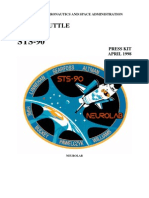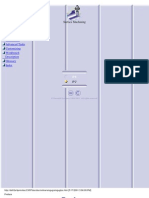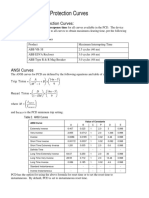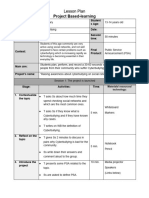Quiz Answers
Quiz Answers
Uploaded by
Chuah Chong YangCopyright:
Available Formats
Quiz Answers
Quiz Answers
Uploaded by
Chuah Chong YangOriginal Description:
Copyright
Available Formats
Share this document
Did you find this document useful?
Is this content inappropriate?
Copyright:
Available Formats
Quiz Answers
Quiz Answers
Uploaded by
Chuah Chong YangCopyright:
Available Formats
Exam
\
Name_______________________________
MULTIPLECHOICE. Choosetheonealternativethatbestcompletesthestatementoranswersthequestion,
1) Atapproximatelywhatt_ __ ~ l J f u l l moonbeonyourmeridian?
A)6AM B) midnight C) 6PM D) 9AM E) noon
2) Kepler'sthirdlaw,p2 a
3
, meansthat
A) theperiodofaplanetdoesnotdependonitsmass.
___Ii!,..B) planetsthatarefartherfrom theSunmoveatsloweraveragespeedsthannearerplanets.
C)allorbitswiththesamesemimajoraxishavethesameperiod.
D)a planet'sperioddoesnotdependontheeccentricityofitsorbit.
E) Alloftheabovearecorrect.
3) Whichofthefollowingis/lot oneof,norfollowsdirectlyfrom,Kepler'slaws?
A)Asaplanetmovesarounditsorbit,itsweepsoutequalareasinequaltimes.
B) TheorbitofeachplanetabouttheSunisanellipsewiththeSunatonefocus.
___,.. C)Theforceofattractionbetweenanytwoobjectsdecreaseswiththesquareofthedistancebetweentheir
centers.
D) Moredistantplanetsmoveatslowerspeeds.
E) A planettravelsfaster whenitisnearertotheSunandslowerwhenitisfartherfromtheSun.
4) Whatis acircumpolar star?
A) astarthatisclosetothenorthcelestialpole
B) astarthatisvisiblefromtheArcticorAntarcticcircles
C)astarthatisclosetothesouthcelestialpole
D) astarthatmakesadailycirclearoundthecelestialsphere
4 E) a starthatalwaysremainsaboveyourhorizon
5) WhydidPtolemyhavetheplanetsorbitingtheearthon"circlesuponcircles"inhismodeloftheuniverse?
I " A) toexplainthefactthatplanetssometimesappeartomovewestward,ratherthaneastward,relativetothe
starsinoursky
B) toexplainwhytheGreekswereunabletodetectstellarparallax
C) toproperlyaccountforthevaryingdistancesoftheplanetsfromtheearth
D) toexplainwhymoredistantplanetstakelongertomakeacircuitthroughtheconstellationsofthezodiac
E) toexplainwhyVenusgoesthroughphasesasseenfromtheearth
6) WhichofthefollowingisnottrueaboutAldebaran?
__Ii". A) It isayoungstar
B) It isknownasthe"eyeofthebull"
C) It isintheconstellationTaurus
D)It isaredgiantstar
E) It ispartofthewintercircle
1
7) If theMoonisrisingatmidnight,thephaseoftheMoonmustbe
---i!'_A) thirdquarter.
B) waxingcrescent.
C) firstquarter.
D)full.
E) waningcrescent.
8) WhenCopernicusfirstcreatedhisSun-centeredmodeloftheuniverse,itdidnotleadtosubstantiallybetter
predictionsofplanetarypositionsthanthePtolemaicmodel.Whynot?
._.. A) Copernicususedperfectcirclesfortheorbitsoftheplanets.
B) CopernicusplacedtheplanetsinthewrongordergoingoutwardfromtheSun.
e) CopernicusmisjudgedthespeedsatwhichtheplanetsorbittheSun.
D) CopernicusplacedtheSunatthecenterbutdidnotrealizethattheMoonorbitstheearth.
E) Copernicusmisjudgedthedistancesbetweentheplanets.
.,
9) Whydoweseeessentiallythesameface oftheMoonatalltimes?
A) becausetheMoondoesnotrotate
B) becausetheMoonhasanearlycircularorbitaroundtheearth
C) becausetheSunilluminatesonlyonehalfatatime
$ D) becausetheMoon'srotationalandorbitalperiodsareequal
E) becausetheotherface pointstowardusonlyatnewmoon,whenwecan'tsee theMoon
SHORTANSWER. Writethewordorphrasethatbestcompleteseachstatementoranswersthequestion.
10) WhatisthenameofthebrightstarinOrion's"knee"?
11) Whatstarisjustaboutdirectlyoverheadinthelateeveningthistimeofyear?
12) DescribetwoobservationsthatGalileomadethathelpedsupporttheCopernicanmodelofthesolarsystem.
13) DescribewhattheseasonswouldbelikeiftheEarth'saxiswastilted90degrees(insteadoftheactualtilt of23.5
degrees).
2
N,me 2.
MULTIPLE CHOICE. Choose the one alternative that best completes the statement or answers the question.
1) We can learn a lot about the properties of a star by studying its spectrum. All of the following statements are
true except one. Which one?
A) The peak of the star's thermal emission tells us its temperature: Hotter stars peak at shorter (bluer)
wavelengths.
---,)III'B) The total amount of light in the spectrum tells us the star's radius.
C) We can look at Doppler shifts of spectral lines to determine the star's speed toward or away from us.
D) We can identify chemical elements present in the star by recognizing patterns of spectral lines that
correspond to particular chemicals.
2) A skater can spin faster by pulling in her arms closer to her body or spin slower by spreading her arms out
from her body. This is due to
A) conservation of momentum.
B) conservation of energy.
C) Newton's third law.
D) the law of gravity.
E) conservation of angular momentum.
3) The mass of Jupiter can be calculated by
A) measuring the orbital speed of one of Jupiter's moons.
B) measuring the orbital period and distance of Jupiter's orbit around the Sun.
C) measuring the orbital period and distance of one of Jupiter's moons.
D) knowing the Sun's mass and measuring how Jupiter's speed changes during its elliptical orbit around the
Sun.
E) knowing the Sun's mass and measuring the average distance of Jupiter from the Sun.
4) You observe a distant galaxy. You find that a spectral line normally found in the visible part of the spectrum is
shifted toward the infrared. What do you conclude?
A) The galaxy is moving away from you.
B) The composition of the galaxy is changing.
C) The galaxy is moving toward you.
D) The galaxy is made purely of hydrogen.
E) The galaxy has very weak gravity.
5) The fact that Voyager 10 continues to speed out of the solar system, even though its rockets have no fuel, is an
example of
A) Newton's third law of motion.
B) the universal Jaw of gravitation.
C) Newton's second law of motion.
D) Newton's first law of motion.
E) none of the above
1
6) Atwhichlunarphase(s)aretidesmostpronounced(e.g., thehighesthightides)?
A) newmoon
B) full moon
C)firstquarter
-.a,. D) bothnewandfull moons
E) bothfirstandthirdquarters
7) Whichofthefollowingbest describestheoriginofoceantidesonEarth?
___ .A) TidesarecausedbythedifferenceintheforceofgravityexertedbytheMoonacrossthesphereofthe
-, earth.
B) Tidesarecausedprimarilybythegravitationalforce oftheSun.
C) Tidesarecaused bythe23 1/2tiltoftheearth'srotationalaxisto theeclipticplane.
D)TidesarecausedonthesideoftheearthnearesttheMoonbecausetheMoon'sgravityattractsthewater.
E) TheMoon'sgravitypullsharderonwaterthanonland,becausewateris lessdensethanrock.
8) Grass(thatishealthy)looksgreenbecause
A) ittransmitsgreenlightandemitsothercolors. B) itreflectsgreenlightandabsorbsothercolors.
C)itabsorbsgreenlightandemitsothercolors. D)itemitsgreenlightandabsorbsothercolors.
9) Whenanelectroninanatomgoesfromahigherenergystatetoalowerenergystate,theatom
A) absorbsaphotonofaspecificfrequency.
B) canabsorbaphotonofanyfrequency.
C) canemitaphotonofanyfrequency.
-.. D)absorbsseveralphotonsofaspecificfrequency.
......." E) emitsaphotonofaspecificfrequency.
10) Supposeyouseetwostars:abluestarandaredstar.Whichofthefollowingcanyouconcludeaboutthetwo
stars? AssumethatnoDopplershiftsareinvolved.(Hint: Thinkaboutthelawsofthermalradiation.)
A) Theredstaris moremassivethanthe bluestar.
B) Theredstarhasahottersurfacetemperaturethanthebluestar.
= C) Thebluestarhasahottersurfacetemperaturethantheredstar.
D) The bluestarismoremassivethantheredstar.
E) Thebluestarisfartherawaythanthe redstar.
SHORTANSWER. Writethewordorphrasethatbestcompleteseachstatementoranswersthequestion.
11) WhatisthenameofthebrightstarinLeo?'
12) Whenyou"followthearc"ofstarsin thehandleoftheBigDipper,whatstardoyoucometo?
l3) StateNewton'sthreelawsofmotion.
2
Exam
MULTIPLE CHOICE. Choose the one alternative thatbest completes the statement or answers the question.
1) According to the nebular theory, how did the Oort cloud form?
A) It is material left over from the interstellar cloud that never contracted with the rest of the gases to form the
solar nebula.
B) It is made of planetesimals that formed beyond Neptune's orbit and never accreted to form a planet.
C) It is made of planetesimals formed in the outer solar system that were flung into distant orbits by
encounters with the jovian planets.
D) It is made of planetesimals between the orbits of Mars and Jupiter that never formed into a planet.
E) It consists of objects that fragmented from the protosun during a catastrophic collision early in the
formation of the solar system.
2) At approximately what time would a first quarter moon rise?
A) midnight B) 6 PM C) 9 AM D) noon E)6AM
3) Why did the solar nebula heat up as it collapsed?
A) Collisions among planetesimals generated friction and heat.
13) Nuclear fusion occurring in the core of the protosun produced energy that heated the nebula.
C) Radiation from other nearby stars that had formed earlier heated the nebula.
D) The shock wave from a nearby supernova heated the gas.
E) As the cloud shrank, its gravitational potential energy was converted to kinetic energy and then into
thermal energy.
4) Which of the following are relatively unchanged fragments from the early period of planet building in the solar
system?
A) Oort cloud comets
B) meteorites
C) asteroids
D) Kuiper belt comets
_.111". E) all of the above
5) What was the frost lin!' of the solar system?
A) the distance from the Sun where temperatures were low enough for metals to condense, between the Sun
and the present-day orbit of Mercury
B) the distance from the Sun where temperatures were low enough for hydrogen and helium to condense,
between the present-day orbits of Jupiter and Saturn
C) the distance from the Sun where temperatures were low enough for rocks to condense, between the
present-day orbits of Mercury and Venus
D) the distance from the Sun where temperatures were low enough for hydrogen compounds to condense
into ices, between the present-day orbits of Mars and Jupiter
E) the distance from the Sun where temperatures were low enough for asteroids to form, between the
present-day orbits of Venus and Earth
1
6) Whathappenedduringtheaccretion phaseoftheearlysolarsystem?
A) Thesolarnebula differentiatedintometalsinsideofthefrost lineandicesbeyond.
B) Atomsandmoleculesin thegasbondedtogetherandsolidified.
e) Earthgaineditsoceansfrom icyplanetesimalcapture.
iSGz. D) Particlesgrewbycollidingandstickingtogether.
E) Largeplanetesimalscapturedatmospheresfrom the solarnebula.
7) Whichofthefollowingstatementsis not anobservedpatternofmotioninoursolarsystem?
A) Almostall moonsorbittheirplanetin thesamedirectionastheplanet'srotation.
..- , , ~ . . B) Mostplanetsorbitatthesamespeed.
e) Mostplanetaryorbitslienearlyin thesameplane.
D) Mostplanetsrotatein thesamedirectionin whichtheyorbit.
E) All planetsorbittheSuninthesamedirection.
8) Whyarctheinnerplanetsmadeofdensermaterialsthantheouterplanets?
A) Inthebeginning,whentheprotoplanetarydiskwasspinningfaster,centrifugal forces flungthelighter
materialstowardtheouterpartsofthesolarnebula.
13) Densermaterialswereheavierandsanktothecenterofthenebula.
e) TheSun'sgravitypulleddensermaterialstowardtheinnerpartofthesolarnebula,whilelightergases
,
--
escapedmoreeasily.
D) Whenthesolarnebula formedadisk,materialsnaturallysegregatedintobands,andinourparticularsolar
systemthedensermaterialssettlednearertheSunwhilelightermaterialsarefoundintheouterpart.
E) Intheinnerpartofthenebulaonlymetalsandrockswereabletocondensebecauseofthehigh
temperatures,whereashydrogencompounds,althoughmoreabundant,wereonlyabletocondenseinthe
coolerouterregions.
9) Whatarethemainconstituentsofthejovianplanets?
A) ammoniaandwater
B) nitrogenandmethane
e) hydrogenandhelium
D) rockymineralsandwater,asonEarth
E) ammoniaandmethane
10) Accordingtoourtheoryofsolarsystemformation, whatisPluto?
A) Plutoissimplyanoddballplanetandthusrepresentsoneofthe"exceptions"thatthenebulartheory
cannotexplain.
B) Plutoisaterrestrial planetthatwasshotoutfromtheinnersolarsystemto itspresentlocationasthemost
distantplanet.
e) Plutoisa verysmall jovianplanet.
D) Plutois aterrestrial planetthathappened to formatalargedistancefrom theSun.
E) PlutoisthelargestoftheKuiper-bellcomets. (" \~ \ ,1,.. ~ , . 1,: (,f r )
SHORTANSWER. Writethewordorphrasethatbestcompleteseachstatementoranswersthequestion.
11) ExplainwhytheearlyEarthdid notform withwater,andhowitgaineditlaterin itsformation.
2
21' tl Exam
2. ----l- ____
MULTIPLECHOICE. Choosetheonealternativethatbestcompletesthestatementoranswersthequestion.
1) Whydoestheearthhavethestrongestmagneticfield amongtheterrestrialworlds?
A)It is theonlyonethathasametalliccore.
B) It isthemostvolcanicallyactiveworld.
e) It isbyfarthelargestterrestrial world.
D) It rotatesmuchfasterthananyotherterrestrialworld.
41 ____"., E) It istheonlyonethathasbothapartiallymoltenmetalliccoreandreasonablyrapidrotation.
2) Olympus Mons isa
A) largelava plainonthe Moon.
B) shieldvolcanoonMars.
e) stratovolcanoontheMoon.
D)shieldvolcanoonVenus.
stratovolcanoonMercury.
3) Theskyis bluebecause
A) theSunmainlyemitsbluelight.
B) theatmosphereabsorbsmostlybluelight.
C) theatmospheretransmitsmostlybluelight.
D)moleculesscatterredlightmoreeffectively thanbluelight.
t
'>
E) moleculesscatterbluelightmoreeffectivelythanredlight.
4) TherearenoaurorasonVenusbecauseit
A) lacksanionosphere.
B) istoohot.
e) lacksatmosphericoxygen.
D) lacksstrongwinds.
t
E) lacksastrongmagneticfield.
5) TheCaloris Basin onMercurycoversalargeregionoftheplanet,butfewsmallercratershaveformedontopof
it. Fromthisweconcludethat
A)erosiondestroyedthesmallercratersthatformedonthebasin.
B) Mercury'satmospherepreventedsmallerobjectsfromhittingthesurface.
e) theCaloris Basin wasformed byavolcano.
D) onlyverylargeimpactorshitMercury'ssurfacein thepast.
E) theCilloris Basin formed toward theendofthesolarsystem'speriodofheavybombardment.
1
6) WhatwouldhappentoEarthifwesomehowmovedourplanettotheorbitofVenus?
s
A)Earthwouldsuffera runawaygreenhouseeffectandbecomeashotorhotterthanVenus.
B) Beingsomuchcloserto theSunwouldalmostimmediatelycausethesurfaceofEarthtomelt,andallour
citieswouldthenbedestroyedbythehotlava.
e)Thefact thatwehaveoceanswould moderatethetemperaturechangeduetomovingourplanet,so
temperaturewouldhardlychangeataiL
D)Temperatureswouldriseonlyslightly,butenoughtomeltthepolarcaps.
7) whichofthefollowingbestdescribeswhythesmallerterrestrialworldshavecoolerinteriorsthanthelarger
t haverelativelymoresurfaceareacomparedtotheirvolumes.
B) Theywerecoolerwhentheyformed.
e)ThesmalleronesarefartherfromtheSun.
D)Theyhaverelativelyfewerradioactiveelements.
E) Theyhadmorevolcaniceruptionsin thepast,whichreleasedtheirinternalheat.
8) Everysummer,whenyou looklowonthesouthernhorizonaroundmidnight,you arclookingtowards
,.. A)theouterpartsofourgalaxy
- .,B) thecenterofourgalaxy
e)theMoon
D)Jupiter
E) Toronto
9) Whyisn'ttheearth'satmospheremostlyhydrogen?
A)EarthformedtooclosetotheSun for anyplanetesimalstohavehydrogen.
B) LightgasessuchashydrogenmoveJasterthanheaviergasesandescapefrom theearth'sgravitational
-----, field.
e)All thehydrogen wasblastedawayduringtheearlybombardmentstage thesolarsystem.
D)Allthehydrogenreactedwithoxygenandformed theoceans.
E) Thehydrogenis frozen inthepolaricecaps.
10) Howdidthelunarmaria form?
A) Volatilesescapingfrom theMoon'sinteriorheatedanderodedthesurfaceintheregionsofthemaria.
B) LargeimpactsfracturedtheMuon'slithosphere,allowinglavatofill theimpactbasins.
e)ThegiantimpactthatcreatedtheMoonleftsmoothareasthatwecall themaria.
D) Themaria aretheresultofgradualerosionbymicrometeoritesstrikingtheMoon.
E) Theearlybombardmentcreated heatthatmelted thelunarsurfacein theregionsofthemariti.
11) Whatis the troposphere?
A) thehighestlayerintheatmosphere
B) thepartoftheatmospherethatabsorbsultraviolet
C) thepartoftheatmospherethatabsorbsopticallight
D) thepartoftheatmospherethatabsorbsXrays
tz E) thelowestlayerintheatmosphere
2
Exam I"!'\' S
ea.-=---_
MULTIPLECHOICE. Choosetheonealternativethatbestcompletesthestatementoranswersthequestion,
1) WheredidcometsthatarenowintheOortcloudoriginallyform?
....,A)nearthejovianplanets
D) insideJupiter'sorbit
C) outsideNeptune'sorbit
D) withinthesolarnebula,butfaroutsidetheorbitofPluto
E) alloftheabove
2) Whichmoonhasthemostsubstantialatmosphere?
A) Ganymede B) Mimas C)10 D) Europa
3) Whatmechanism ismostresponsibleforgeneratingthe internalheatof10 thatdrivesthevolcanicactivity?
A)bombardment
B) radioactivedecay
C) accretion
) D)tidal heating
E) differentiation
4) Whichdirectiondoacomet'sdustandplasma tailspoint?
A) perpendicularto theeclipticplane D) straightbehindthecometin itsorbit
'--'> C) generallyawayfrom theSun D) alwaysalmostduenorth
5) WhyisJupiterdenserthanSaturn?
A) It ismadeofadifferentcompositionthanSaturn,includingahigherproportionofhydrogencompounds
androcks.
B) ItscoreismuchlargerthanSahun's.
C)Theextra massofJupitercompressesitsinteriortoagreaterextentthanthatofSaturn.
D)It hasagreaterproportionofhelium to hydrogencomparedtoSaturn.
E) It is unknownwhythisisso.
6) WhatisJupiter'sGreatRedSpot?
R ".A)along-Jived,high-pressurestorm
B) theplacewherereddishparticlesfrom10 impactJupiter'ssurface
C)a hurricanethatcomesandgoesonJupiter
D) a largemountainpeakpokingupabovetheclouds
E) theplacewhereJupiter'sauroraismostvisible
1
7
7) Whydoasteroidsandcometsdifferincomposition?
A) Cometsformedfromthejoviannebula,whileasteroidsdidnot.
B) Asteroidsformed insidethefrostline,whilecometsformed outside.
C) Cometsaremuchlargerthanasteroids.
0)Asteroidsandcometsformedatdifferenttimes.
E) Asteroidsaremuchlargerthancomets.
8) HowdoastronomersthinkJupitergeneratesitsinternalheat?
A) radioactivedecay
B) internalfrictionduetoitshighrotationrate
C) bycontracting,changinggravitationalpotentialenergyintothermalenergy
0)nuclearfusioninthecore
E) chemicalprocesses
9) Planetaryringsarc
A) composedofalargenumberofindividualparticlesthatorbittheir planetin accordwithKepler'sthirdlaw.
B) nearertotheirplanetthananyoftheplanet'slargemoons.
C) knowntoexistfor allofthejovianplanets.
0)orbitingin theequatorialplaneoftheirplanet.
E) alloftheabove
10) Whenwesecameteorshower,it meansthat:
A) youshouldduckandrunfor covertoavoidbeingblastedontheheadbyarockfrom space.
B) anEarth-approachingasteroidhasrecentlycomeveryclosetoourplanet.
C)thesolarwindisunusuallystrong.
._-)
0)Earthiscrossingtheorbitofa comet.
11) Whyisn'ttherea planetwheretheasteroidbeltislocated?
A)Therewastoomuchrockymaterialtoformaterrestrialplanet,butnotenoughgaseousmaterialtoform a
jovianplanet.
B) A planetonceformedhere,butitwasbrokenapartbyacatastrophiccollision.
C)Thetemperaturein thisportionofthesolarnebulawasjustrighttopreventrockfromstickingtogether.
0)GravitationaltugsfromJupiterpreventedmaterialfrom collectingtogethertoformaplanet.
E) Therewasnotenoughmaterialinthispartofthesolarnebula to forma planet.
SHORTANSWER. Writethewordorphrasethatbestcompleteseachstatementoranswersthequestion.
12) Brieflydescribe theevidencesuggestingthata lO-kmasteroidorcomethittheearthatthetimeofthedinosaur
extinction.
13) Brieflydescribehowanimpactcouldlead to amassextinction.
2
MULTIPLECHOICE. Choosetheonealternativethatbestcompletesthestatementoranswersthequestion,
1) "HotJupiters"inotherstarsystemsare
A)Gasgiantplanetsfarfrom theirstan.whichgenerateheatbygravitationalcontraction
B) Gasgiantswhichshinevia nuclearreactionsinthecores
........,., C)Gasgiantsfoundveryclosetotheirhoststars. ....,
D) MassiveterrestrialplanetsfoundnearJovian planets
2) Whichofthefollowingisnottrueofthetransittechniquefor findingplanets:
A)It cangiveusmeasurementsofaplanet'ssize.
B) 1t cangiveusmeasurementsofa planet'schemicalcomposition
C)1t cangiveveryaccuratemeasurementsoftheplanet'smass
'"D)It candetectplanetsnomatterhowtheirorbitistiltedrelativetoourviewpoint.
3) Whatprocessesareinvolvedinthesunspotcycle?
A) variationsofthesolarthermostat
B) gravitationalcontractionoftheSun
C)thewindingofmagneticfield linesduetodifferentialrotation
D) wavemotionsin thesolarinterior
4) TheDopplertechniquesearchesfor planetsby
,. A) Measuringthechangingvelocityofthestarasitis pulledonbyanorbitingplanet.
B) Blockingthelightfrom astarsowecanseetheitsnearbyplanets
C)Watchingastar'spositionin theskychangeasaplanethlgSonit
D) Measuringthevelocityofa planetasitorbitsitshoststar
5) Atapproximatelywhattimewoulda firstquartermoonrise?
A) 6AM B) 9AM C)6PM. D) midnight ...noon
6) WhathappensintheradiativezoneoftheSun?
A) Thesun'smagneticfield trapshotgasandmakesitradiate.
B) Photonsmoveenergyoutwardsbydoingaslow"randomwalk"astheyinteractwithmatter.
C) Photonsfly freelythroughthisregionduetoitslowdensity.
D) Nuclearreactionsproducedhydrogenandhelium.
Radioactiveclementsreleaseenergy.
1
7) In the late 1800s, Kelvin and Helmholtz suggested that the Sun stayed hot thanks to gravitational contraction.
What was the major drawback of this idea?
A) It predicted that the earth would also shrink, which would make it impossible to have stable geology on
our planet.
B) It predicted that the Sun would shrink noticeably as we watched it, and the Sun appears to be stable in
size.
C) It is physically impossible to generate heat simply by making a star shrink in size.
D) It predicted that the Sun could last only about 25 million years, which is far less than the age of the earth.
8) The fact that so many of the planets find other stars are so much more massive than the planets in our
solar system probably is a sign that
A) The planets we find around other stars are much younger than our planets
B) Our solar system is not typical of other planetary systems
C) We are looking at types of stars which can only make high mass planets.
.,. D) Our techniques for finding planets can currently only find these kinds of planets
9) The fundamentaI nuclear reaction occurring in the core of the Sun is:
A) radioactive decay. ... B) nuclear fusion of hydrogen to helium.
C) nuclear fission. D) nuclear fusion of helium to carbon.
10) An easy way to identify the constellation Cassiopeia in the fall sky is to ...
a ,. A) Look for a W-shaped group of stars
B) Look for four sttlrs forming a square
C) Follow the stars in Orion's Belt to Cassiopeia
D) Look for the double star cluster
E) Follow the arc of stars in the Big Dipper's handle
11) What happens to energy in the convection zone of the Sun?
A) Energy is consumed in the convection zone by the creation of electrons and positrons.
....... .. B) Energy is transported outward by the rising of hot plasma and the sinking of cooler plasma.
C) Energy slowly leaks outward through the diffusion of photons that repeatedly bounce off ions and
electrons.
D) Energy is produced in the convection zone by nuclear fusion.
SHORT ANSWER. Write the word or phrase that best completes each statement or answers the question.
12) Describe how we think"Hot Jupiters" may have formed.
13) Describe the story explaining why Cassiopeia was thrown into the night sky
2
You might also like
- File 4 - 80Document3 pagesFile 4 - 80Chuah Chong YangNo ratings yet
- Icons - The DC Comics and Wildstorm Art of Jim LeeDocument304 pagesIcons - The DC Comics and Wildstorm Art of Jim LeeRuan Gomes100% (2)
- File 1 - 65Document4 pagesFile 1 - 65Chuah Chong Yang100% (1)
- File 3 - 70Document3 pagesFile 3 - 70Chuah Chong YangNo ratings yet
- XRD Test1Document6 pagesXRD Test1Chuah Chong YangNo ratings yet
- UCLA Astronomy 3 Practice ExamDocument7 pagesUCLA Astronomy 3 Practice ExamSharon XuNo ratings yet
- Final 071212 WithAnswerKeyDocument20 pagesFinal 071212 WithAnswerKeyChuah Chong YangNo ratings yet
- Moment of Inertia of CoinDocument1 pageMoment of Inertia of Coinjdlawlis0% (1)
- Astronomy - Chapter 18 TestDocument36 pagesAstronomy - Chapter 18 TestJ. R. Silvey100% (3)
- Cluster Ages Lab Exercise MCDocument10 pagesCluster Ages Lab Exercise MCdan25% (4)
- Astronomy - Chapter 13 TestDocument37 pagesAstronomy - Chapter 13 TestJ. R. Silvey100% (3)
- Primus Rf-25en PDFDocument2 pagesPrimus Rf-25en PDFCosasa Soluciones en SeguridadNo ratings yet
- Lubricants For The Manufacturing IndustryDocument20 pagesLubricants For The Manufacturing IndustrynarenjiNo ratings yet
- Friendships - Mediator (INFP) Personality - 16personalitiesDocument5 pagesFriendships - Mediator (INFP) Personality - 16personalitiesAmy PhicenNo ratings yet
- How Hard Should You Push DiversityDocument7 pagesHow Hard Should You Push DiversitySanjana Ramavarapu100% (1)
- St. Joseph Astronomy Olympiad 2015 (Junior)Document3 pagesSt. Joseph Astronomy Olympiad 2015 (Junior)Science Olympiad Blog100% (1)
- Stellar Classification - Wikipedia PDFDocument24 pagesStellar Classification - Wikipedia PDFDaniel BarriosNo ratings yet
- VenusDocument23 pagesVenusAdamImanNo ratings yet
- Solar System KEY PDFDocument32 pagesSolar System KEY PDFAchmad FahrizaNo ratings yet
- Europa - OrbiterWikiDocument7 pagesEuropa - OrbiterWikiKim NguyenNo ratings yet
- Lagrange PointsDocument4 pagesLagrange PointsHandita Sutoyo100% (1)
- Chapter 3Document12 pagesChapter 3IVIYI3r41nNo ratings yet
- Astronomy NotesDocument12 pagesAstronomy NotesYQ WheatonNo ratings yet
- Space Colonization Using Space-Elevators From Phobos: Leonard M. WeinsteinDocument9 pagesSpace Colonization Using Space-Elevators From Phobos: Leonard M. WeinsteinMindSpaceApocalypse100% (1)
- Our Universe Book Version 2.00 CompressedDocument49 pagesOur Universe Book Version 2.00 CompressedLakshmi KanthNo ratings yet
- Solar System - Wikipedia, The Free EncyclopediaDocument24 pagesSolar System - Wikipedia, The Free EncyclopediaAriana BalidoyNo ratings yet
- Lib-Big-Q-Why-Is-Earth-Rotating-57173-Article Quiz and AnswersDocument6 pagesLib-Big-Q-Why-Is-Earth-Rotating-57173-Article Quiz and Answersapi-302899266No ratings yet
- James Beazley - The Shape of The UniverseDocument12 pagesJames Beazley - The Shape of The UniverseJamesDBeazleyNo ratings yet
- Galaxy Analysis and Identification Lab ProcedureDocument3 pagesGalaxy Analysis and Identification Lab ProcedurejoeNo ratings yet
- Supercomplete Nasa SP 446 Pioneer First To Jupiter Saturn and BeyondDocument221 pagesSupercomplete Nasa SP 446 Pioneer First To Jupiter Saturn and BeyondjanmyslikovjanNo ratings yet
- Comets IIDocument726 pagesComets IIsrolandNo ratings yet
- Matahari Planet Satelit Semulajadi (Bulan)Document13 pagesMatahari Planet Satelit Semulajadi (Bulan)Anonymous zp6PgvANo ratings yet
- Neutrino Detection: Challenges and Thrills: What'S Inside?Document6 pagesNeutrino Detection: Challenges and Thrills: What'S Inside?Vijay NaikNo ratings yet
- STS-90 Press KitDocument44 pagesSTS-90 Press KitBob AndrepontNo ratings yet
- The Earth's Magnetic Field - Basics PDFDocument15 pagesThe Earth's Magnetic Field - Basics PDFAntonio Jose da CostaNo ratings yet
- LifecyleofstarsDocument32 pagesLifecyleofstarsWayne David C. PadullonNo ratings yet
- Origin of UniverseDocument10 pagesOrigin of Universehaider-ijaz-4545No ratings yet
- SPACE Notes 4 and 5Document16 pagesSPACE Notes 4 and 5Shashwat TripathiNo ratings yet
- A Brief History of ElectromagnetismDocument15 pagesA Brief History of ElectromagnetismHernán H.No ratings yet
- Heliosheric Physics and Cosmic RaysDocument168 pagesHeliosheric Physics and Cosmic RayshumejiasNo ratings yet
- Exploring The Night Sky Lab 2Document2 pagesExploring The Night Sky Lab 2humza sattiNo ratings yet
- Practice Test SpaceDocument8 pagesPractice Test Spaceapi-291011460100% (1)
- Solar StormsDocument6 pagesSolar StormsgoxtadNo ratings yet
- Stage 2: Protostar: Color of StarsDocument2 pagesStage 2: Protostar: Color of StarsJon Paul GuiaparNo ratings yet
- The Cosmic Perspective, 7th International Edition 20 - TestbankDocument18 pagesThe Cosmic Perspective, 7th International Edition 20 - TestbankEdward YangNo ratings yet
- Earth, Moon, Mars or Beyond?: Being The Space Debate of The TimesDocument114 pagesEarth, Moon, Mars or Beyond?: Being The Space Debate of The TimesBILLY CHILONGO SICHONENo ratings yet
- Mars Quick FactsDocument10 pagesMars Quick FactsAviation/Space History Library100% (6)
- Planet X Global WarmingDocument4 pagesPlanet X Global WarmingAnthonyNo ratings yet
- Theory of Time MachineDocument127 pagesTheory of Time MachineUday HiwaraleNo ratings yet
- New Horizons Fact Sheet 2006Document2 pagesNew Horizons Fact Sheet 2006Bob Andrepont100% (1)
- Risks & Rewards: Space TourismDocument19 pagesRisks & Rewards: Space TourismjastybernardNo ratings yet
- Question According To Syllubas PDFDocument48 pagesQuestion According To Syllubas PDFBrowny hustler100% (1)
- A Bibliography On The Search For Extraterrestrial Intelligence-NASA-RP-1021Document136 pagesA Bibliography On The Search For Extraterrestrial Intelligence-NASA-RP-1021Neo Anderson100% (1)
- The Jovian Beet: Un H CC Mpli NTDocument6 pagesThe Jovian Beet: Un H CC Mpli NTBob Andrepont100% (1)
- Jupiter and SaturnDocument27 pagesJupiter and Saturnbryan tolabNo ratings yet
- Nuclearweapons Characteristic HandbookDocument91 pagesNuclearweapons Characteristic HandbookSwagmaster3000No ratings yet
- Galaxy Morphology: By: Amie Sulaiman Saron Ephraim Stephannie GrijalvaDocument16 pagesGalaxy Morphology: By: Amie Sulaiman Saron Ephraim Stephannie GrijalvaBudi AfriyansyahNo ratings yet
- Deep Impact Comet Encounter Press KitDocument36 pagesDeep Impact Comet Encounter Press KitBob AndrepontNo ratings yet
- Chapter 9 Space Weather: Edited By: Teacher Nurlailie MJDocument29 pagesChapter 9 Space Weather: Edited By: Teacher Nurlailie MJNurlailie Md JamilNo ratings yet
- Measuring The Stars (Chps. 16-17)Document5 pagesMeasuring The Stars (Chps. 16-17)Yoyo Kirby2No ratings yet
- NST1502 Assignment 2Document8 pagesNST1502 Assignment 2JessicaNo ratings yet
- Beyond The Solar SystemDocument10 pagesBeyond The Solar SystemDyuvan D MachaarandaNo ratings yet
- 03+ +Origins+of+Modern+AstronomyDocument33 pages03+ +Origins+of+Modern+AstronomyReyes LykaNo ratings yet
- Lab SheetDocument1 pageLab SheetgladysNo ratings yet
- Magnetic ReconnectionDocument62 pagesMagnetic Reconnectionjburleson11100% (2)
- Sample QuestionsDocument9 pagesSample Questionsbabarrayyan292No ratings yet
- Space Physics QDocument9 pagesSpace Physics Qthethmusan.2007No ratings yet
- Midterm SolutionsDocument12 pagesMidterm Solutionsozworld3100% (1)
- Physics 10 Revision Answer KeyDocument6 pagesPhysics 10 Revision Answer KeygoldenaboudyNo ratings yet
- Petrochemicals An Overview (STUDENT) (2of3)Document224 pagesPetrochemicals An Overview (STUDENT) (2of3)Chuah Chong YangNo ratings yet
- Problem Set 9Document1 pageProblem Set 9Chuah Chong YangNo ratings yet
- Petroleum Refining (1 of 3)Document257 pagesPetroleum Refining (1 of 3)Chuah Chong Yang100% (1)
- Petrochemicals An Overview (STUDENT) (1of3)Document152 pagesPetrochemicals An Overview (STUDENT) (1of3)Chuah Chong YangNo ratings yet
- Li Ion Removal Using ZeoliteDocument10 pagesLi Ion Removal Using ZeoliteChuah Chong YangNo ratings yet
- Carbon 94 (2015) 243-255 (Koh)Document13 pagesCarbon 94 (2015) 243-255 (Koh)Chuah Chong YangNo ratings yet
- Petrochemicals An Overview (STUDENT) (3of3)Document175 pagesPetrochemicals An Overview (STUDENT) (3of3)Chuah Chong Yang100% (1)
- Petroleum Refining (2 of 3)Document247 pagesPetroleum Refining (2 of 3)Chuah Chong YangNo ratings yet
- Appl Surf Sci 2019 494 137-151 (KOH and K2CO3)Document15 pagesAppl Surf Sci 2019 494 137-151 (KOH and K2CO3)Chuah Chong YangNo ratings yet
- Removal of Removal of Iron (Fe) and Manganese (MN) : DR Liu YuDocument20 pagesRemoval of Removal of Iron (Fe) and Manganese (MN) : DR Liu YuChuah Chong YangNo ratings yet
- Adv. Funct. Mater. 2016, 26, 7955-7964 Supp (MOH)Document21 pagesAdv. Funct. Mater. 2016, 26, 7955-7964 Supp (MOH)Chuah Chong YangNo ratings yet
- Ion ExchangeDocument63 pagesIon ExchangeChuah Chong YangNo ratings yet
- CB Ad Ti THL Carbon Adsorption Technology: Process DesignDocument50 pagesCB Ad Ti THL Carbon Adsorption Technology: Process DesignChuah Chong YangNo ratings yet
- Lecture 3 - Coagulation and FlocculationDocument93 pagesLecture 3 - Coagulation and FlocculationChuah Chong YangNo ratings yet
- Lecture 5 - FiltrationDocument90 pagesLecture 5 - FiltrationChuah Chong YangNo ratings yet
- Lecture 4 - SedimentationDocument99 pagesLecture 4 - SedimentationChuah Chong YangNo ratings yet
- Transport Phenomena: Cheg 355Document19 pagesTransport Phenomena: Cheg 355Chuah Chong YangNo ratings yet
- Lecture 6 - DisinfectionDocument91 pagesLecture 6 - DisinfectionChuah Chong YangNo ratings yet
- Chemical Reaction Safety: Paul Sharratt 19 August 2019Document32 pagesChemical Reaction Safety: Paul Sharratt 19 August 2019Chuah Chong YangNo ratings yet
- File 2 - 70Document3 pagesFile 2 - 70Chuah Chong Yang100% (1)
- CH1004-mass-part 4 (AY11)Document83 pagesCH1004-mass-part 4 (AY11)Chuah Chong YangNo ratings yet
- Aristotle Nicomachean EthicsDocument5 pagesAristotle Nicomachean EthicsTrishaDime100% (1)
- Prodi Manajemen: e - Jurnal Riset Manajemen Fakultas Ekonomi Dan Bisnis Unisma WebsiteDocument10 pagesProdi Manajemen: e - Jurnal Riset Manajemen Fakultas Ekonomi Dan Bisnis Unisma WebsiteputrifaNo ratings yet
- Draw The Following Object Converting The Right Side View Into A Half Section. Draw The Appropriate Cutting Plane LineDocument2 pagesDraw The Following Object Converting The Right Side View Into A Half Section. Draw The Appropriate Cutting Plane LineAliceAlormenuNo ratings yet
- Education: José Bayoán Santiago CalderónDocument3 pagesEducation: José Bayoán Santiago CalderónJosé Bayoán Santiago CalderónNo ratings yet
- FCR Prima t2 Brochure 01 PDFDocument2 pagesFCR Prima t2 Brochure 01 PDFshoaibNo ratings yet
- Effect SizeDocument3 pagesEffect Sizekinhai_seeNo ratings yet
- CATIA - Surface MachiningDocument458 pagesCATIA - Surface MachiningAmr FawzyNo ratings yet
- Term 2 Revision ResourceDocument96 pagesTerm 2 Revision ResourceNyra HillsNo ratings yet
- Transpersonal Psychology As A Science: October 2018Document25 pagesTranspersonal Psychology As A Science: October 2018Reyhan. ReyzNo ratings yet
- Financial Research Correlation AnalysisDocument27 pagesFinancial Research Correlation Analysisisabe lle0% (1)
- ABB Protection CurvesDocument60 pagesABB Protection Curvesnabil160874No ratings yet
- CHAPTER ONE SalisuDocument31 pagesCHAPTER ONE SalisusalisuNo ratings yet
- 1038-Article Text-6574-1-10-20230622Document6 pages1038-Article Text-6574-1-10-20230622Cindy SulistyowatiNo ratings yet
- How To Take Care of An Egg Baby ProjectDocument3 pagesHow To Take Care of An Egg Baby Projectzzaentz0% (1)
- On Some Aspects of The Historiography of Colonial India (1982)Document4 pagesOn Some Aspects of The Historiography of Colonial India (1982)Piero Donnini ArezzoNo ratings yet
- Lesson Plan and RubricsDocument6 pagesLesson Plan and RubricsEnglish AccessNo ratings yet
- Opengl SynopsisDocument5 pagesOpengl SynopsisPratik Kanthi0% (1)
- 259 605 1 PBDocument8 pages259 605 1 PBn2763288No ratings yet
- Chapter 2 Strategic ThinkingDocument25 pagesChapter 2 Strategic ThinkingNaimNo ratings yet
- Archive Matic ADocument21 pagesArchive Matic ADora PalomoNo ratings yet
- Knowledge of Sericulture Extension Worke PDFDocument5 pagesKnowledge of Sericulture Extension Worke PDFTruyen NgoNo ratings yet
- Debate Mechanics and Guidelines DebateDocument7 pagesDebate Mechanics and Guidelines DebateJilaida Mae Luna MontesNo ratings yet
- Internet Fun Activities Games Reading Comprehension Exercis - 7074Document4 pagesInternet Fun Activities Games Reading Comprehension Exercis - 7074aalyaarabiNo ratings yet
- Rhetoric and Composition BookDocument172 pagesRhetoric and Composition Bookapi-3817692100% (2)
- (Find The Connections!) : Ask: What Is The Relationship Between Chef and Knife?Document3 pages(Find The Connections!) : Ask: What Is The Relationship Between Chef and Knife?MHAY LYN GONZALES100% (1)


















































































































